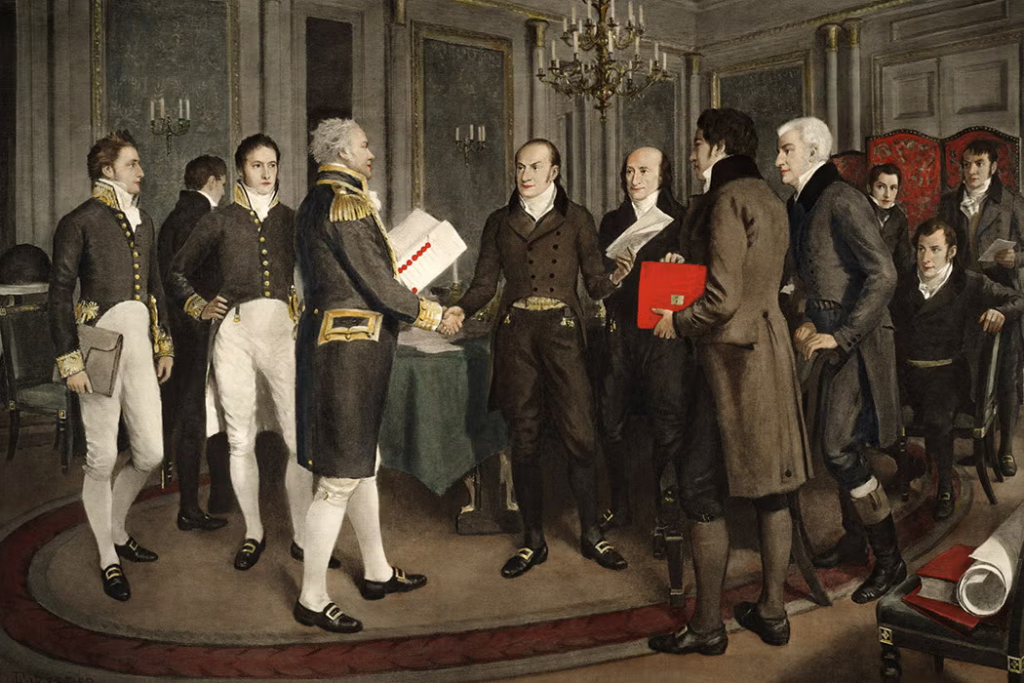In February 1815, the U.S. Senate ratified the Treaty of Ghent, officially ending the War of 1812. But as the dust settled, Americans found themselves in a familiar predicament—one that eerily resembled the country’s struggles 25 years earlier, when the federal government was just finding its footing. The war had exposed a brutal truth: the Republican vision of governance simply didn’t work.

The Republican Playbook: A Recipe for Disaster?
Before the war, President James Madison and his fellow Republicans championed a limited government philosophy inspired by Thomas Jefferson’s vision of an “agrarian republic.” Their governing principles included:
- Low taxes and minimal government spending
- No standing army and a barebones navy
- Free trade with low tariffs
- No central bank
These ideas may have sounded great in theory, but the War of 1812 exposed their flaws spectacularly. Without sufficient funds, the federal government struggled to finance the war. Without adequate infrastructure, invading Canada became a logistical nightmare. The poorly trained militias performed dismally, and without a national bank, securing war-time funding was next to impossible. Madison’s dreams of a self-sufficient agricultural utopia had come crashing down.
Madison’s 180-Degree Turn
Faced with the undeniable failures of Republican policies, Madison did the unthinkable—he pivoted toward policies that looked strikingly similar to those of his old rival, Alexander Hamilton. In his 1815 and 1816 State of the Union addresses, Madison proposed a bold plan for national reconstruction:
- Increased military spending and federal oversight of militia training
- Protective tariffs to support American industry
- Large-scale infrastructure projects, including roads, bridges, and canals
- Reestablishment of a national bank
Had you closed your eyes while listening, you might have mistaken Madison for Hamilton himself. The same man who had once vehemently opposed a national bank and protective tariffs was now championing them as the solution to America’s woes. This dramatic shift left everyone stunned—Federalists were delighted, while Republicans cried betrayal. One Republican even accused Madison of being “more Hamiltonian than Hamilton himself.”
The Birth of the American System
Madison’s surprising shift in economic philosophy laid the groundwork for what became known as the “American System.” While he provided the initial vision, it was younger politicians like Henry Clay and John C. Calhoun who turned it into reality. The core elements of the American System—strong federal investment in infrastructure, a protective tariff policy, and a national bank—shaped U.S. economic policy for the next four decades, right up until the Civil War.
One of the first major victories of this new approach was the creation of the Second Bank of the United States in 1816. With three times the starting capital of its predecessor, the bank helped stabilize the national economy. Around the same time, Congress passed legislation to construct the Cumberland Road, the first major federally funded highway. Though Madison would later veto a broader infrastructure bill, his policies had already set the wheels in motion for a transportation revolution.
From Canals to Railroads: The Transformation of America
The most spectacular outcome of the American System was the development of a national transportation network. In 1817, New York began construction on the Erie Canal—a project so ambitious that many believed it would take 30 years to complete. Instead, it was finished in just eight. Stretching 525 miles from Albany to Buffalo, the Erie Canal connected the Hudson River to the Great Lakes, slashing transportation costs and transforming New York City into the nation’s premier port.
Before the canal, shipping a ton of goods from New York City to Buffalo cost around $100 and took 45 days. After its completion, the same trip cost only $6 and took just nine days. The economic boom was so profound that other states rushed to build their own canals. By the late 1820s, steam-powered railroads were emerging, further accelerating America’s industrial expansion. By 1830, the Baltimore & Ohio Railroad was operational, reducing overland transportation costs by 95% and increasing speed fivefold.
Wall Street, Banks, and the Rise of American Finance
Another unintended consequence of Madison’s policies was the rise of American finance. The revival of the national bank in 1816 triggered a banking boom, with more than 300 state-chartered banks emerging in the following decades. In 1817, the New York Stock Exchange was founded at 40 Wall Street, laying the foundation for the nation’s financial epicenter. Once shunned as a tool of Federalist elitism, banking and finance became integral to America’s economic success.
The Legacy of Madison’s Transformation
Madison’s about-face in economic policy had far-reaching consequences. The American System not only fueled industrialization but also strengthened national unity. The interconnected web of roads, canals, and railroads turned the U.S. into a truly unified market. This economic cohesion played a crucial role in the North’s dominance during the Civil War—after all, it was the industrialized, infrastructure-rich North that ultimately overpowered the agrarian South.
While Madison himself may not have foreseen these long-term effects, his willingness to adapt ensured the survival and prosperity of the young republic. His story serves as a reminder that true leadership isn’t about sticking rigidly to ideology—it’s about recognizing when change is necessary for the greater good.

No comments yet.